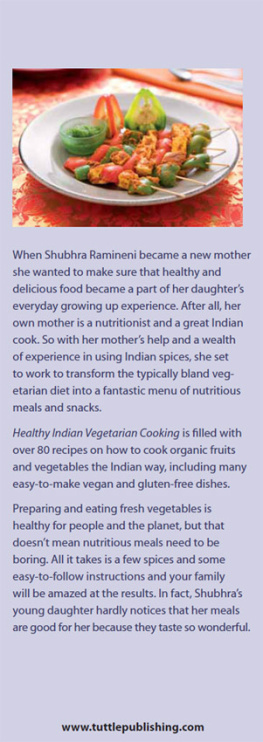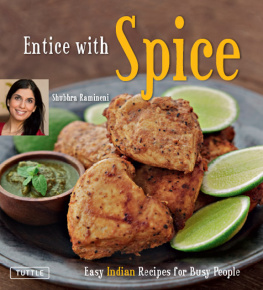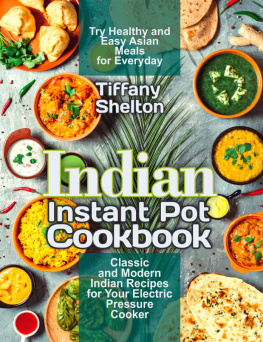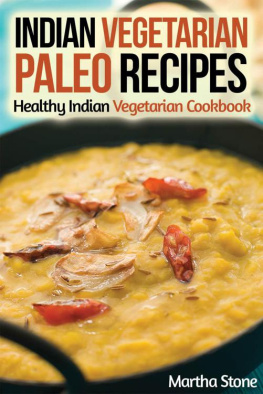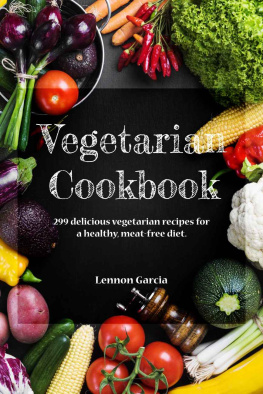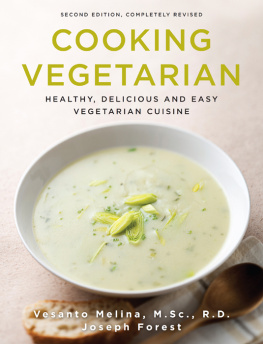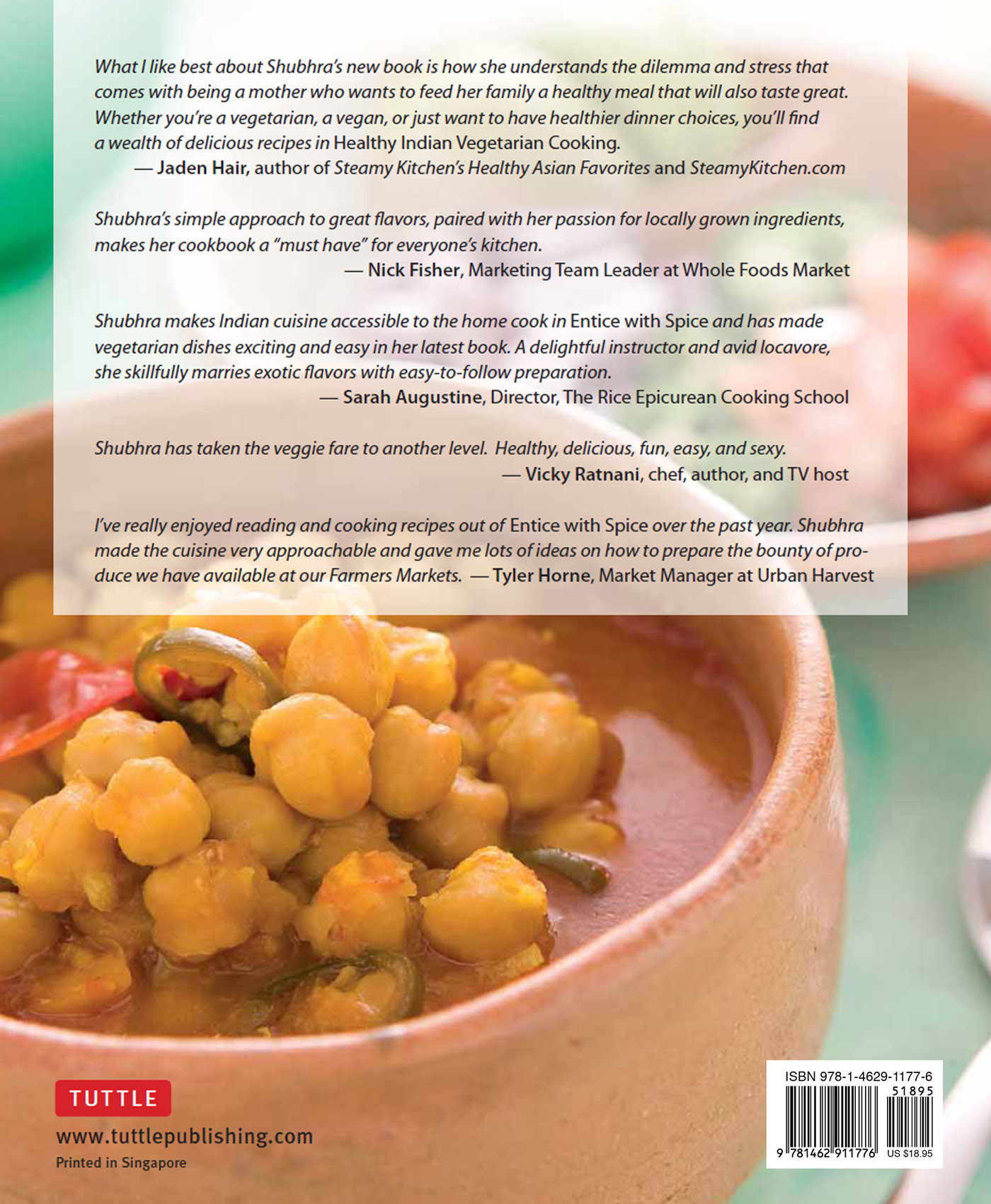Acknowledgments
I would like to thank my dearest sweet husband, Naveen,
for supporting and encouraging me every day in every way. Whether it's fixing a nerve-wracking computer malfunction, helping with the never-ending pile of dishes, caring for our darling daughter, or tasting and approving all of the fruit and vegetable dishes in this book, he is always there for me. I want to thank my delightful daughter, Jaya, for always finding fun in every situation, even when I had to work long hours on my computer for this book. She would imitate me and bring her own toy computer and sit on her little table with a pencil, notebook, toy cell phone, and calculator.
At the same time, she also had dishes cooking in her play kitchen while I was in my kitchen testing recipes.
I am also very appreciative of my dear friend, Anik Sayad Desjardins, who was there for me at a moment's notice, always willing to give a helping hand and sharing her culinary knowledge. Thanks for being a kind, amazing person and a wonderful friend.
Thank you Monica Pope for writing the foreword for my book. I am honored to have met you and to teach your Cooking Therapy classes along with you... such fun, organized chaos they are! I admire your efforts to be eco-conscious from recycling the oil in your restaurant kitchen to supporting local farmers.
I would like to thank my editor, Bud Sperry, my designer, Irene Ho, and my editorial supervisor, June Chong, for working with me on my vision of this book to come together beautifully. And for the amazing photographs in this book, a thank you to Minori Kawana. A heartfelt thanks to Rowan Muelling-Auer and Christopher Johns at Tuttle Publishing for your continuous support and for doing all the amazing things you both do.
Enjoying Nature's Bounty
I grew up on a predominantly vegetarian diet, and appreciate the freshness, health benefits, taste, and variety of meatless dishes that can be easily made. After having my daughter, I have become more aware of our food and the ingredients on food labels. I want to ensure that my family eats wholesome, natural foods. My daughter's love of vegetables led to my creating recipes to incorporate her favorite veggies, such as adding broccoli to my original Vegetable Rice Pilaf (page ) dish.
Like my mother, one of my most enjoyable hobbies is gardening, and my daughter is following in my footsteps. I have learned some great growing tips from my mom for a bountiful garden full of tomatoes, opo squash, eggplants, and okra. It is so fun and rewarding to plant fruits and vegetables, watch them grow, and then harvest them and cook them into delicious dishes for my family and friends to savor. My daughter was so excited when she first saw the oranges on my tree growing bigger and bigger and even more excited when I plucked it for her and peeled it open for us to enjoy!
I find it so exciting when I cook and share vegetarian dishes with my friends from different ethnicities and they are pleasantly surprised at the ease of preparation and great flavors. My Indian friends also are amazed at how vegetables not native to Indian cuisine, such as collard greens and parsnips, can be cooked with Indian spices to create unique and tasty dishes.

With people becoming more health and environment conscious and more aware of where their food comes from and what is in it, cooking and eating more vegetarian meals prepared from fruits, vegetables, grains, nuts, lentils, legumes, tofu, and homemade cheese is becoming the norm of healthy living today. Whatever the reason for following the growing trend of vegetarianism, or at least reducing the amount of consumed meat (raised ethically and farmed humanely), there are definitely benefits for your health and the environment. Using Indian influences for cooking techniques and flavors, this book will guide you to easily making healthy and tasty vegetarian, vegan, and gluten-free dishes to dine on from breakfast to dinner and from appetizers to desserts. With my simple, nutritious recipes you can enjoy delicious, fresh, unprocessed food without hormones, preservatives, and other chemical pesticides and fertilizers. If you only have frozen vegetables on hand, feel free to use them as well.
Are You a Locavore?
You might be a locavore, and not even know it! Locavores are trying to support local farmers and the planet by being aware of where their food comes from in the world. Locally grown food has a shorter transportation distance, resulting in fresher food and fewer emissions in the environment.
Many people shop their neighborhood farmers markets and food cooperatives (co-ops) for fresh, locally grown seasonal produce, or are joining a Community Supported Agriculture (CSA) to receive weekly shares of farm-fresh fruits and vegetables. The contents of their bounty vary depending on seasonality and availability.
Locavores follow the slow food movement that encourages the enjoyment of regional produce that are often grown organically and by sustainable farming methods that protect and conserve natural resources.


If you were ever at a loss of how to prepare your fresh bounty of produce, this book will help to prepare the produce into delicious, flavorful, and satisfying dishes using Indian spices.perhaps juicy pears to make a delightful chutney to spread on your breakfast toast, tender yellow squash to make a spicy curry to enjoy with Basmati rice, or fragrant sweet mangoes to make an unforgettable ice cream for dessert, and so many more recipes for you to relish!
About Indian Spices
My recipes in this book use fresh fruits, vegetables, grains, nuts, lentils, legumes, tofu, and cheese that are prepared with Indian inspired techniques and flavors. Why Indian style? Because Indian food is traditionally vegetarian food, cooked with a variety of exotic spices, so its the natural cuisine for delicious and healthy vegetarian food, including vegan and gluten-free dishes. Indian spices really give unique and wonderful tastes to dishes. Some spices enhance the natural flavors of fruits and vegetables, while others jazz them up to make it an extravagant meal. Best of all, the spices incorporated in my recipes are easily accessible in most local grocery stores.
In addition to transforming a fruit or vegetable into an exotic delight, Indian spices have many healing properties and health benefits such as the anti-inflammatory property of turmeric to calm arthritis pain, heartburn relief from cardamom, tummy ache soothing from carom seeds, and much, much more.
If you are new to cooking with Indian spices, I would suggest starting off simply with five spices: salt, black pepper, ground red pepper (cayenne), cumin seeds, and ground turmeric. Find recipes in this book that just use those spices, and then you can build your spice collection with cloves, mustard seeds, cardamom, coriander seeds, saffron, and more. I cook with spices and ingredients that can be easily found at a local grocery store, without having to make special trips to ethnic markets.
Next page
